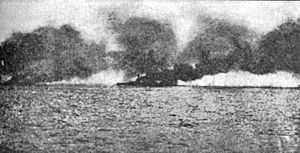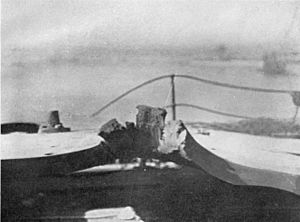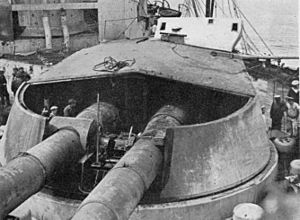Francis Harvey facts for kids
Quick facts for kids
Francis Harvey
|
|
|---|---|

Francis Harvey, VC
|
|
| Born | 29 April 1873 Upper Sydenham, Kent, England |
| Died | 31 May 1916 (aged 43) HMS Lion, North Sea |
| Allegiance | United Kingdom |
| Service/ |
Royal Marine Light Infantry |
| Years of service | 1892–1916 |
| Rank | Major |
| Battles/wars | First World War |
| Awards | Victoria Cross Mentioned in Despatches |
Major Francis John William Harvey (born April 29, 1873 – died May 31, 1916) was a brave officer in the Royal Marine Light Infantry during the First World War. He is famous for his actions during the Battle of Jutland, where he saved many lives. For his incredible bravery, he was given the Victoria Cross, which is the highest award for military courage in the British and Commonwealth forces.
Major Harvey came from a family of military heroes. He was an expert in naval artillery, which means he knew a lot about big ship guns. He served on many large warships, training others and commanding gun crews. He was specifically asked to join HMS Lion, which was the main ship of the British battlecruiser fleet. On this ship, he fought in important battles like the Battle of Heligoland Bight, the Battle of Dogger Bank, and the Battle of Jutland.
During the Battle of Jutland, Major Harvey was badly hurt by German shells. Even as he was dying, he gave a crucial order to flood the magazine of Q turret on the ship Lion. This action stopped the huge amount of cordite (explosive material) stored there from blowing up. If it had exploded, the entire ship and everyone on it would have been destroyed. He died moments later, but his final act likely saved over a thousand lives. Later, Winston Churchill praised his actions, saying it was one of the greatest deeds in the history of the Royal Marines.
Contents
Early Life and Family
Francis Harvey was born in Upper Sydenham, Kent, England, on April 29, 1873. His father, John William Francis Harvey, was an officer in the Royal Navy. In 1884, when Francis was 11, his family moved to Southsea. He went to Portsmouth Grammar School, where he did very well in his studies. He was especially good at languages and debating.
Francis came from a long line of military people. His great-great-grandfather, John Harvey, died fighting in a famous naval battle in 1794. His great-grandfather, Admiral Sir Edward Harvey, and his grandfather, Captain John Harvey, were also important military figures.
Becoming a Gunnery Expert
After school, Francis decided to join the military. He was accepted into officer training at both the Royal Military College and the Royal Naval College, Greenwich. He chose the Royal Naval College to become a Royal Marines officer. He graduated in 1892 and became a full lieutenant the next year. His first ship was HMS Wildfire.
After only a year at sea, Harvey went back to shore to take special gunnery courses. By 1896, he was a top-level instructor in naval gunnery. He then served on the cruiser HMS Phaeton in the Pacific. In 1898, the Admiralty thanked him for a report he wrote about San Diego Harbour. When he returned home, he became an Assistant Instructor for Gunnery in Plymouth. During this time, he married Ethel Edye, and they had a son named John.
Between 1898 and 1904, Harvey spent a lot of time with the Channel Fleet. He served on ships like HMS Edgar and {{HMS|Diadem|1896|6]], teaching and practicing gunnery. On January 28, 1900, he was promoted to captain. In 1903, he joined HMS Royal Sovereign, which was the first of many large ships where he taught gunnery to the Channel Fleet's heavy units. By 1909, Harvey had served on HMS Duke of Edinburgh, HMS St George, and the new battlecruiser HMS Inflexible.
In 1910, Harvey became the Instructor of Gunnery at Chatham Dockyard. The next year, he was promoted to major. A report about the gunnery school praised his work, saying that the training was excellent, thanks to Major F.J.W. Harvey.
Because of this great report, Major Harvey became the senior marine officer on HMS Lion. This huge 27,000-ton ship was the main ship of the British battlecruiser fleet. The Lion had eight powerful 13.5-inch guns. Major Harvey was in Q turret, directing how these guns were used. Under the ship's new commander, Rear-Admiral David Beatty, Major Harvey served as the top marine officer as the First World War began. This was his first military campaign.
First World War Battles

Major Harvey quickly saw action. His first combat was at the Battle of Heligoland Bight just weeks after the war started. On August 28, 1914, Lion and her squadron, which included HMS Queen Mary and HMS Princess Royal, entered the Heligoland Bight. German and British cruiser forces were already fighting there. One German cruiser had already been sunk when Beatty's force arrived. The German flagship SMS Cöln and cruiser SMS Ariadne were caught by surprise in the fog. They were destroyed by the powerful shells from Beatty's battlecruisers. German Admiral Leberecht Maass and over 1,000 of his sailors were killed. Major Harvey's guns hit the German cruisers many times.
Six months later, Major Harvey's guns again caused serious damage to a German force at the Battle of Dogger Bank. For months, a German battlecruiser squadron had crossed the North Sea and attacked British coastal towns. On January 24, 1915, they tried again. But this time, British intelligence had found out about the German plan. The Admiralty sent Beatty's force to stop them.
Beatty's and Hipper's squadrons met at 9:00 AM. During the fight, Lion was left open to attack because of a mix-up in communication. This allowed SMS Moltke to fire more accurately. The British flagship was in trouble until one of Lion's shots hit one of Seydlitz's turrets. A huge explosion destroyed the turret next to it and killed 160 men. The German ship only survived because a sailor named Wilhelm Heidkamp bravely opened the water valves to the magazines, even though they were glowing red hot.
Lion was badly damaged by shells from SMS Derfflinger. Her engines were failing, so she fell back to attack the already sinking SMS Blücher. Because of misunderstood signals, the rest of the British fleet returned to help Lion with this task. This allowed the damaged German fleet to escape. The British then destroyed the Blücher, killing 792 of her crew. After the battle, Major Harvey stayed on Lion at Rosyth for the rest of 1915 and the first five months of 1916. He continued his gunnery training, getting ready for a major fleet battle. This big battle happened on the last day of May, when the British fleet sailed to fight the main German High Seas Fleet at the Battle of Jutland.
After the Dogger Bank battle, Major Harvey wrote to another officer. He described his experiences, saying that fighting in a turret wasn't uncomfortable. He felt "curiosity" and thought he would be safe. But he also knew that if a shell hit his turret, it would likely come right in and kill him.
Heroism at Jutland
Beatty's battlecruisers led the British fleet into battle on the afternoon of May 31, 1916. Around 2:15 PM, scouting ships spotted the German fleet. Beatty moved to attack. The German commander, Hipper, was ready. His battlecruisers were lined up to face Beatty's ships. Hipper also knew that the main German battleship fleet was coming up behind him.
At 3:45 PM, Beatty's ships came within range of the German fleet, and the battle began. The Germans found their target better and faster than the British. The British ships were silhouetted against the sun, making them easier targets. German shells hit the British ships hard, while the German ships were untouched for the first 10 minutes. During this part of the battle, Lion was hit by nine shells from SMS Lützow.
One shell, at 4:00 PM, hit the Q turret. It punched a piece of the thick armour plate into the turret and exploded. This blew off the armoured roof of the turret and started a fire. A team worked from outside the turret to put out the fire.
The first explosion killed or wounded everyone inside the gun house. Major Harvey, despite being severely wounded and burned, gave orders. He told his crew to close the magazine doors and flood the magazine compartments with water. This was a critical action to stop the cordite (explosive powder) in the magazines from blowing up. He then turned to his sergeant, the only man still standing, and told him to go to the bridge and give a full report to the ship's captain, Ernle Chatfield. The sergeant immediately went to the bridge and told the captain what Harvey had done before getting his own wounds treated.
Below the armoured deck, Stoker 1st Class William Yeo was given the job of carrying out Major Harvey's last orders. The magazine was quickly flooded and locked within minutes of the hit. However, some cordite charges that had fallen from the gun house were not removed. There were also still charges ready in the working chamber. Many crewmen were still in the shell room, magazine handing room, and working chamber. The fire, which was thought to be out, grew stronger and ignited the remaining cordite. This caused a large explosion at 4:28 PM, killing the turret crew. The flames from this explosion reached as high as the ship's masts. Even with the precautions taken, the magazine doors were found to be badly bent later. Only the seawater in the magazine behind the doors prevented the blast from reaching inside.
Other ships in the battlecruiser fleet were not as lucky. Around the same time Major Harvey died, HMS Indefatigable was ripped apart by a series of magazine explosions. This killed 1,013 lives. Just minutes later, HMS Queen Mary exploded "like a puffball" in a huge column of smoke, killing 1,275 sailors. Hours later, during the main battle, Rear-Admiral Horace Hood's ship HMS Invincible was also destroyed with 1,032 lives. All three of these ships were lost because of magazine explosions, similar to the one that Major Harvey narrowly prevented on Lion.
Remembering a Hero
Major Harvey's body was taken from the damaged Q turret after the battle. He was buried at sea with full military honours, along with the other 98 sailors who died on Lion. His incredible bravery was recognized. He was mentioned by name in Admiral Jellicoe's report after the battle. He was also given the Victoria Cross after his death.
His wife, Ethel, received the award from King George V at Buckingham Palace on September 15, 1916. Later, in 1973, his son, Lieutenant-Colonel John Malcolm Harvey, loaned his father's medals to the Royal Marines Museum. Major Harvey's name is carved on the Chatham Naval Memorial. This memorial remembers those who died at sea and have no known grave. It is looked after by the Commonwealth War Graves Commission.
See also
- Wilhelm Heidkamp
- Aldar Tsydenzhapov




